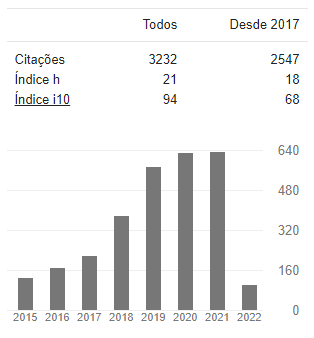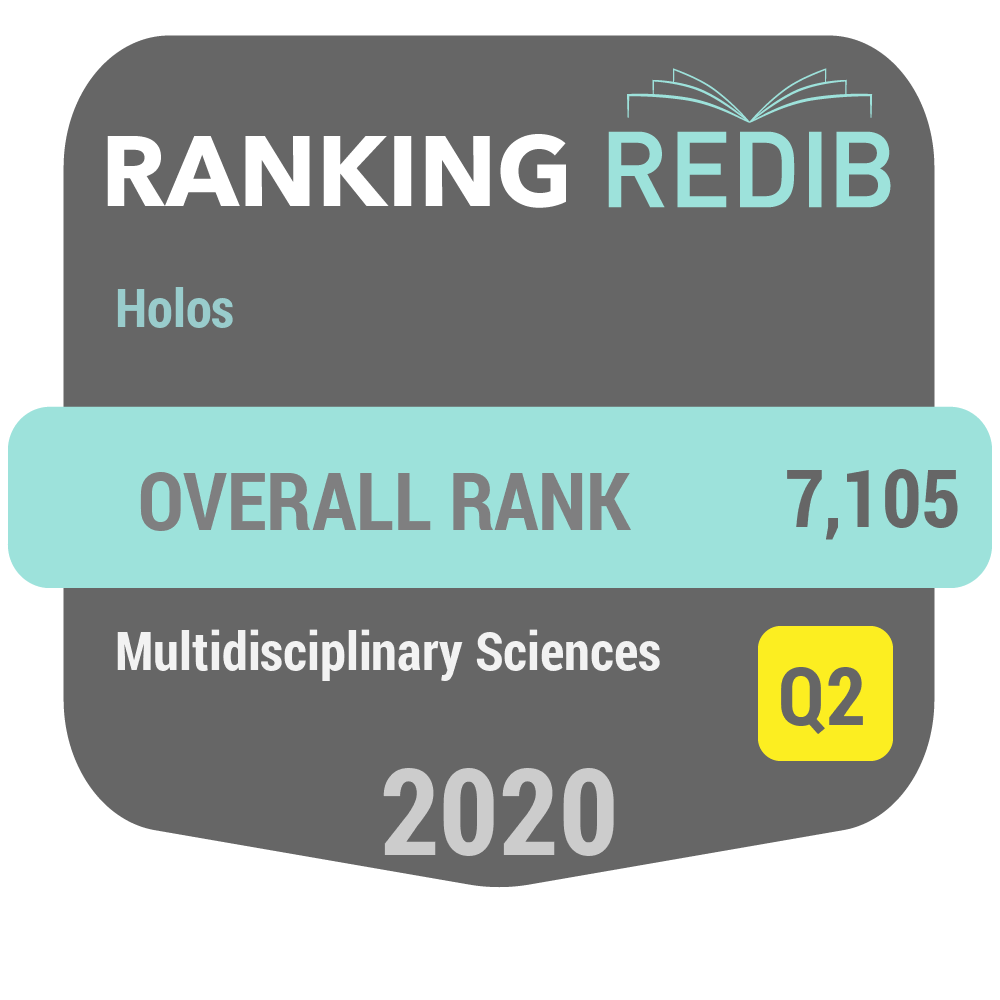A EVOLUÇÃO DO BALANCED SCORECARD – UMA COMPARAÇÃO COM OUTROS SISTEMAS
DOI:
https://doi.org/10.15628/holos.2017.5438Palavras-chave:
Balanced Scorecard, evolução, aplicação prática, IAM- Intangible Assets Monitor, Skandia NavigatorResumo
No presente trabalho efetuou-se uma análise da evolução histórica do Balanced Scorecard (BSC) comparando a evolução desta ferramenta de gestão com a evolução de outras ferramentas suas contemporâneas. Nesta análise foi demonstrado que a evolução sofrida pelo BSC estará muito relacionada com o facto de o conceito sempre ter tido, ao longo do tempo e desde a sua aparição, uma ampla aplicação prática. Visou também analisar-se o efeito que a utilização deste instrumento introduziu nas práticas de gestão das organizações.
O trabalho foi desenvolvido através de análise bibliográfica dos principais textos publicados pelos autores do Balanced Scorecard e por outros que aportaram contribuições importantes para o tema em análise, assim como da constatação relativa ao facto de os autores do conceito sempre terem desenvolvido a aplicação empírica da sua metodologia, contribuindo para a sua disseminação e esta para a sua evolução.
Assim considera-se poder concluir que a utilização prática do conceito influenciou a evolução do Balanced Scorecard, isto porque é evidente que ao longo do tempo a utilização dada ao BSC fez evoluir o mesmo, e vice-versa, a evolução do mesmo também fez alterar o seu campo de aplicação, a avaliar pelas evoluções mais recentes.Downloads
Referências
ABRAHAMSON, E. e FAIRCHILD, G. (1999). “Management Fashion: Lifecycles, Triggers, and Colective Learning Processes”, Administrative Science Quarterly, December, Vol. 44, n.º 4, pp.708-740.
ADAMS, C. e ROBERTS, P. (1993). “You are what you measure”, Manufacturing Europe, Starling Publications.
ANTHONY, R. e GOVINDARAJAN, V. (2001). Management control systems. Boston, McGraw-Hill.
AX, C. e BJORNENAK, T. (2005). “Bundling and Diffusion of Management Accounting Innovations – The Case of the Balanced Scorecard in Sweden”, Management Accounting Research, March, Vol. 16, n.º 1, pp.1-20.
BHIMANI, A., (1993). “Indeterminacy and the specificity of accounting change: Renault 1898-1938”, Accounting, Organizations and Society, 18(1), pp.1-39.
BRANDON, C.H. e DRTINA, R.E. (1997). Management Accounting: Strategy and Control, Edição Internacional, Editora MacGraw-Hill de Portugal, Lda. Alfragide.
BURNS, J., (1997). A Critique of ‘New’ Institutional Economics-Towards A Processual, Institutionalist Perspective of Management Accounting Change, Papers of the University of Manchester, School of Accounting and Finance.
BURNS, J. and SCAPENS, R., (1998). Conceptualizing Management Accounting Change: an Institutionalist Framework, Papers of the University of Manchester.
BUTLER, A., LETZA, S. e NEALE, B., (1997). “Linking the balanced scorecard to strategy”, Long Range Planning, 30(2), pp.242-253.
CHILD, J., (1984). Organization. A Guide to Problems and Practice, 2nd edition, London, Harper and Row Ltd.
CRUZ, C.P. (2006). Balanced Scorecard – Concentrar uma Organização no que é Essêncial, Vida Económica, Porto.
DIMAGGIO, P. e POWELL, W. (1983). “The Iron Cage Revisited: Institutional Isomorphism and Collective Rationality in Organisational Fields”, American Sociological Review, April, Vol. 48, pp. 147-160.
DOWNING, L.; (Novembro/Dezembro 2000). “Progress report on the Balanced Scorecard: a global users’survey”, Balanced Scorecard Report, Harvard Business School Press, volume 2, n.º 6;
DRUCKER P. (1995). “L´Information dont um Dirigeant à Vraiment Besoin”, L´Expansion Management Review. Juin. pp. 6-14.
GONÇALVES, D. (2003). “Capital Intelectual: considerações sobre a sua valorização”, in Jornal do Técnico de Contas e da empresa, nº 452, pp.182-188.
HOPWOOD, A., 1987. “The archaeology of accounting systems”, Accounting, Organizations and Society, 3, pp.207-234.
INNES, J. and MITCHELL, F., (1990). ” The process of change in management accounting: some field study evidence”, Management Accounting Research, 1, pp.3-1 9.
KANJI, G. (2003), “Performance measurement system”, Total Quality Management, Vol. 13, No. 5, August, pp. 715-728.
KANJI, G. (1998). “Measurement of business excellence”, Total Quality Management, Vol. 9, No. 7, October, pp.633-643.
KANJI, G. e SÁ, P. (2002). “Kanji's business scorecard”, Total Quality Management, Vol. 13, No. 1, January, pp.13-27.
KANJI, G. e SÁ, P. (2001). “Kanji's business scorecard”, Total Quality Management, Vol. 12, No. 7, December, pp. 898-905.
KAPLAN, R.; NORTON, D. (2010). “Managing Alliances with the Balanced Scorecard”, Harvard Business Review, January-February, pp. 114-120.
KAPLAN, R.; NORTON, D. (2008). “Mastering the Management System”, Harvard Business Review, January, Vol. 86, n.º 1, pp. 62-77.
KAPLAN, R.; NORTON, D. (2007). “Using the Balanced Scorecard as a Strategic Management System”, Harvard Business Review, July/August, Vol. 85, n.º 7/8, pp.150-161.
KAPLAN, ROBERT S., NORTON, DAVID P., (2004a). Mapas estratégicos convertendo activos intangíveis em resultados tangíveis, Campus, Rio de Janeiro;
KAPLAN, Robert S.; NORTON, David P. (2004b). “How Strategic Maps Frame an Organization’s Objectives”, Financial Executive, March/April, Vol. 20, n.º 2, pp. 40-45.
KAPLAN, R. S. e NORTON, D. P., (1997). A estratégia em acção: Balanced Scorecard, Campus, Rio de Janeiro.
KAPLAN, R. S. e NORTON, D.P. (1996a). “Using the Balanced Scorecard as a Strategic Management System”, Harvard Business Review. January/February, Vol. 74, n.º 1, pp.75-85.
KAPLAN, R. e NORTON, D. (1996b). The Balanced Scorecard: Translating strategy into action, Harvard Business School Press, Boston.
KAPLAN, R.; NORTON, D. (1993). “Putting the Balanced Scorecard to Work”, Harvard Business Review, September/October, Vol. 71, n.º 5, pp. 134-147.
KAPLAN, R. e NORTON, D. (1992). “The Balanced Scorecard – Measures that Drive Performance”, Harvard Business Review, Jan-Feb, pp.71-79.
KAPLAN, R.S. (1985). “Il faut Modifier nos Méthodes Comptables!”. Harvard L´Expansion. Nº36. pp.53-60.
Karl-Erik Sveiby. Paper for PEI Conference in Stockholm 25 October 1996. Updated April 2001.
KASURINEN, T., (2002). “Exploring management accounting change: the case of balanced scorecard implementation”, Management Accounting Research, 13, pp.323–343.
LAPSLEY, I. and MITCHELL, F., (1994). “Management accounting research: the change agenda”, Management Accounting Research, 5, pp.215-219.
MALMI, T. (2001). “Balanced Scorecards in Finnish Companies: A Research Note”, Management Accounting Research, June, Vol. 12, n.º 2, pp.207-220.
MILLER, P., (1994). “Accounting as Social and Institutional Practice: An Introduction”, in Hopwood, A. and Miller, P. (eds) Accounting as Social and Institutional Practice, Cambridge, University Press, pp.1-39.
MARTÍNEZ RAMOS, M.; HEREDIA ÁLVARO, J. (2003). “El Balanced Scorecard. Estudio del Proceso de Implantación en una Mediana Empresa”, Revista Iberoamericana de Contabilidad de Gestión, Julio/Diciembre, Vol. I, n.º 2, pp.147-168.
MILLER, P., (1991). “Accounting innovation beyond the enterprise: problematizing investment decisions and programming economic growth in the U.K. in the 1960s”, Accounting, Organizations and Society, 18(8), pp.733-762.
MILLER, P. e O’LEARY, T., (1987). “Accounting and the construction of the governable person”, Accounting, Organizations and Society, 12(3), pp.235-265.
MILLER, P. e O’LEARY, T., (1994a). “Accounting, ‘economic citizenship’ and the spatial reordering of manufacture”, Accounting, Organizations, and Society, 19( l), pp.15-43.
MILLER, P. e O’LEARY, T., (1994b). “The factory as laboratory”, Science in Context, 7(3), pp.469-496.
MITCHELL, V.W. e VOLKING, Y.E. (1993). “Analysing the Quality of Management Information: A Suggested Framework”. Management Decision. Vol.31 nº8. pp 12-19.
NORREKLIT, H. (2003). “The balanced scorecard: what is the score? A rhetorical analysis of the balanced scorecard”, Accounting, Organizations and Society, Vol. 28, No. 6, August, pp. 591-619.
NORREKLIT, H. (2000). “The balance on the balanced scorecard - a critical analysis of some of its assumptions”, Management Accounting Research, Vol.11, No.1, March, pp. 65-88;
OLVE, NILS-GÖRAN: ROY, JAN; WETTER, MAGNUS (2001). Condutores da performance: um guia prático para o uso do Balanced Scorecard, Qualitymark, Rio de Janeiro.
PAPALEXANDRIS, A., IOANNOU, G., PRASTACOS, G. e SODERQUIST, K. (2005). “An integrated methodology for putting the balanced scorecard into action”, European Management Journal, Vol. 23, No. 2, April, pp.214-227.
PAPALEXANDRIS, A., IOANNOU, G. e PRASTACOS, G. (2004). “Implementing the balanced scorecard in Greece: a software firm’s experience”, Long Range Planning, Vol. 37, No. 4, August, pp.351-366.
PETTIGREW, A. e WHIPP, R. (1991). Managing change for competitive success, Cambridge, Blackwell.
QUESADO, P.R., RODRIGUES, L.L. e AIBAR GUZMÁN (2014). “EL CUADRO DE MANDO INTEGRAL, EL ACTIVITY BASED COSTING Y LA ACTIVITY BASED MANAGEMENT: UN ESTUDIO EMPÍRICO DE SU INTEGRACIÓN”, RIC - Revista de Informação Contábil, Vol. 8, no 1, Jan-Mar, pp. 71-94. ISSN 1982-3967.
QUESADO, Patrícia Rodrigues (2010). Factores Determinantes de la Implementación del Cuadro De Mando Integral en Organizaciones Públicas y Privadas Portuguesas, Tese de Doutoramento, Universidad de Santiago de Compostela, Facultad de Ciencias Económicas y Empresariales, Departamento de Economía Financiera y Contabilidad, Santiago de Compostela.
QUESADO, Patrícia Rodrigues (2005). O Contributo do Balanced Scorecard para a Gestão Estratégica de Custos: uma Análise Empírica às Grande Empresas Portuguesas, Dissertação de Mestrado, Universidade do Minho, Braga.
RUSSO, J. (2009). Balanced Scorecard para PME, Lídel – edições técnicas, Lda. Lisboa-Porto.
SANTOS, R.A. (2006). Balanced Scorecard em Portugal, Visão, Estratégia e Entusiasmo. Gestão plus Edições, Cascais.
SARAIVA, H. e GABRIEL, V. (2016). “Determinantes da Certificação da Qualidade nas Autarquias Portuguesas”, Revista Portuguesa de Estudos Regionais, nº 41, pp.35-48.
SARAIVA, H.I.B. e ALVES, M.C.G. (2015). “The use of the Balanced Scorecard in Portugal: Evolution and effects on management changes in Portuguese large companies”, Tékhne, Volume 13, Issue 2, July–December 2015, pp. 82–94. doi:10.1016/j.tekhne.2016.04.001
SARAIVA, H. (2011a). “The Balanced Scorecard: The Evolution of the Concept and Its Effects on Change in Organizational Management”, EBS Review, 28, pp.53-66. ISSN 1406-0264.
SARAIVA, H. (2011b). “A evolução do Balanced Scorecard – efeito da sua aplicação prática”, Revista Portuguesa de Contabilidade, V.I, nº2, pp. 265-276.
SCAPENS, R., EZZAMEL, M. e BURNS, J., (1997). “Management Accounting Change”, a research outline and ongoing work at the University of Manchester (CIRAF).
SCAPENS, R., (1994). “Never mind the gap: towards an institutional perspective on management accounting practice”, Management Accounting Research, 5, pp.301 -321.
SCAPENS, R. e ROBERTS, J., (1993). “Accounting and control: a case study of resistance to accounting change”, Management Accounting Research, 4, pp.1-32.
SILK, S. (1998).” Automating the balanced scorecard”, Management Accounting (US), pp.38-44.
SIONCKE, G. (2005), “Implementation of a balanced scorecard in a care home for the elderly: Useful or not?”, Total Quality Management, Vol. 16, No. 8/9, pp.1023-1029.
SVEIBY, KARL ERIK (1997). "The Intangible Assets Monitor", Journal of Human Resource Costing & Accounting, Vol. 2 Iss: 1, pp.73 – 97.
VAIVIO, Juhani, (1999). “Exploring a ‘non-financial’ management accounting change”, Management Accounting Research, 10, pp.409-437
VENKATRAMAN, G. e GERING, M. (2000). “The balanced scorecard”, Ivey Business Journal, Vol. 64, No. 3, January/February, pp.10-14.
VIEDMA MARTÍ, J. (2002). “Un Nuevo Paradigma Emergente de Capital Intelectual”, XII Jornadas Luso-Espanholas de Gestão Científica, UBI, Covilhã.









































